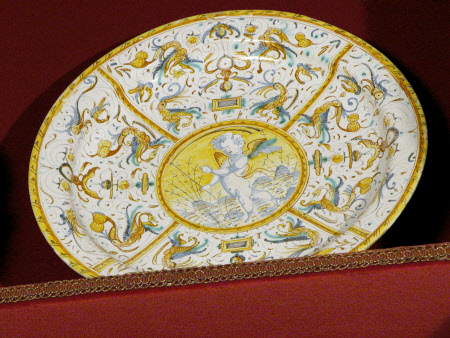Dish
Category
Ceramics
Date
1570 - 1630
Materials
earthenware, tin-opacified lead glaze, polychrome pigments
Measurements
412 mm (Depth)
Place of origin
Urbino
Order this imageCollection
Knightshayes Court, Devon
NT 540403
Summary
Large dish, earthenware with tin-glaze (maiolica), made in Deruta, Italy, ca. 1600; painted in the central reserve with Cupid creating a new bow out of sapling, within a quartered design of grottesche in the style of the Patanazzi workshop.
Full description
Fantastical designs with mythical creatures, called grottesche, were a specialty of the Patanazzi family workshop in Urbino, c. 1570-1630. Grottesche or grotesques were popularized by wall paintings designed by Raphael in the Vatican Loggie, c. 1519, and based on those in the grotto-like underground rooms of Nero’s Golden House, in Rome, discovered in 1480. Their fashionable designs were soon copied at other workshops. This dish was formerly in the collection of Sir William Stirling-Maxwell (1818-1878), 9th Bt., of Keir, Perthshire and later also Pollok, near Glasgow, Scotland. Much of the Stirling family wealth came from West Indian plantations with enslaved African labour for which they received compensation in 1833. Stirling-Maxwell formed the largest collection of Spanish art in Britain, some of which remains at Pollok House, as the contents were gifted to Glasgow Corporation in 1967. Highlights of his maiolica collection were sold by his grandson Lt. Col. William Joseph Stirling (1911-1983) of Keir, Perthshire, Scotland, at Sotheby & Co., London, Catalogue of Fine Italian Majolica, 18 June 1946, included as the last of four items in lot ‘71 An Urbino bowl with turnover rim, painted with “groteche” motifs and in the centre with a seated figure of a woman, 8 ¼ in.; a Plate with Venus and Cupid : another with armorials, 9 ¼ in. ; a large Dish with Cupid in a hilly landscape and “groteche” and “candelieri” motifs “a quatieri”, 16 ½ in., Patanazzi workshop, second half 16th Century.’ Purchased for 12 guineas (£12 11s. 12d.) at the sale by "Sir J Amory", Sir John Heathcoat-Amory (1894-1972), 3rd Bt., of Knightshayes Court. The house, part of the collection, the garden Sir John and Lady Heathcoat-Amory created, and part of the estate were bequeathed to the National Trust by Sir John Heathcoat-Amory in 1972. The maiolica was later given by Joyce, Lady Heatcoath-Amory (1901-1997), née Wethered, a celebrated golfer.
Provenance
From Lady Amory
